Types of parasites
There are different types of worms and protozoa living in the human body:
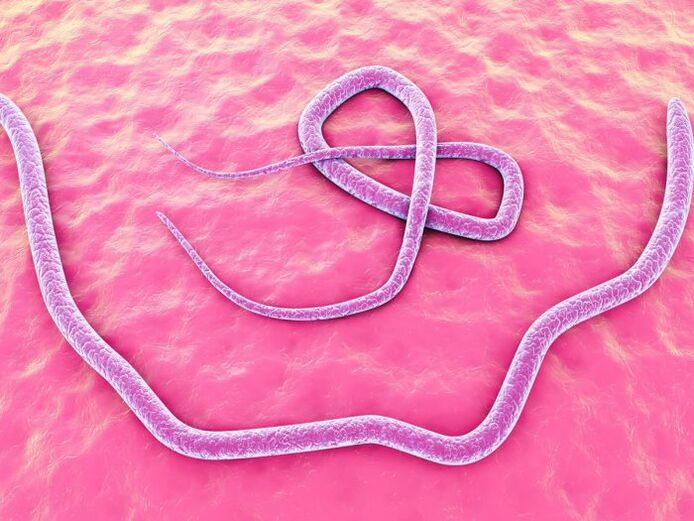
- Helminths. These worms live mostly in the intestines, but can be found in the liver, brain, lungs, heart, kidneys, muscles and other organs. Worms cause dangerous diseases and complications.
- Parasitic protozoa and multicellular (protozoal parasites). These pests are common in different latitudes. These protozoa can infect human intestines, eyes, brain, esophagus, heart, muscles, as well as nerves, liver, skin, and even the genitourinary system. The most common protozoan parasites living in humans are lichens, lamblia, toxoplasmosis, trichomonas, blastocysts, etc. Other organisms that are parasitic to humans are lice, insects, ticks and fly larvae. Their name is ectoparasites. They can parasitize not only the surface of the skin, but also wounds, hair follicles and eyelashes.
- Other parasites are those that affect the subcutaneous tissue more, but can parasitize the urethra and nasopharynx. These are the larvae of some flies, mosquitoes, sand lice.
We have listed the main types of parasites in humans. But if we talk about what kind of parasites live in the human body in our latitudes, the most horrible of them are:
- pig tapeworm;
- wide ribbon;
- pinworms;
- Chinese defect;
- roundworm;
- ripple;
- Trichinella;
- alveococcus;
- whipped up
- dwarf tapeworm;
- bull set up a ribbon;
- liver mixture;
- pulmonary fluke;
- echinococcus.
Diseases they cause
The most dangerous parasites that live in the human body can cause various diseases. Often, a disease caused by a specific parasite has the same name. Thus, various types of parasites in the human body can cause the following diseases:
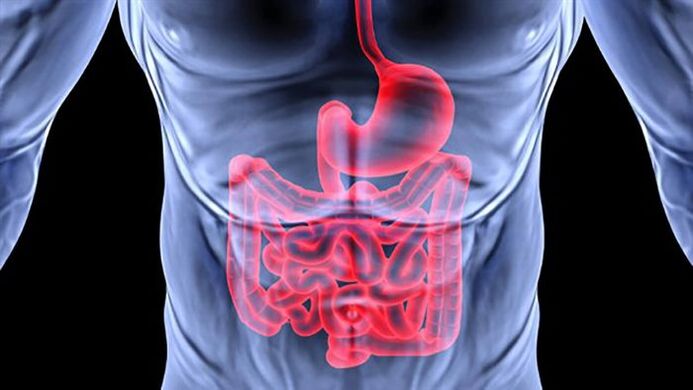
- Some parasites (flukes) inside a person cause trematodes;
- cestodes occur when tapeworms are affected;
- If an adult or child has roundworms in their intestines, nematodes are diagnosed;
- leeches cause hirudinosis;
- Antosephalosis is triggered by scratching.
However, parasites in the human body can infect more than one organ. Depending on the localization of parasites in the human body, the following parasitic diseases differ:
- If the eyes are affected, onhocerciasis, demodicosis, cysticercosis, and miyazis may occur;
- Diseases of the gastrointestinal tract caused by single-celled parasites and helminths - ascariasis, trichinosis, hookworm, enterobiasis, intestinal myasthenia gravis and metagonimiasis;
- Brain diseases - echinococcosis, toxoplasmosis, alveococcosis and cysticercosis;
- Dermatological diseases - demodicosis, lice, pruritus, pulicosis, thrombosis, phthisis;
- Lung pathologies - echinococcosis, ascariasis, acariosis, alveococcosis, tomincosis, etc. ;
- Liver diseases - opisthorchiasis, alveococcosis, echinococcosis, clonoriosis;
- Parasites in the mouth, ears, and mouth can cause different types of myasthenia gravis;
- Heart pathologies - dirofilariasis and echinococcosis;
- Diseases of the genitourinary system - alveococcosis, urinary tract infections, echinococcosis;
- Vascular pathologies - filariasis and schistosomiasis.
symptoms
We thought about what parasites are in the human body. Now let's look at the simplest human parasites and the main symptoms caused by different types of worms. It should be noted that pathogenic worms and protozoan cysts often cause infections that can remain in the environment for a long time, waiting for the right moment.  Under the favorable conditions of a person's internal environment, larvae emerge from cysts that are actively developing in adults.
Under the favorable conditions of a person's internal environment, larvae emerge from cysts that are actively developing in adults.
It is worth explaining what cysts are. Cysts often form the simplest single-celled organisms, bacteria, and protists. Protozoan cysts are a temporary form of an organism's existence under adverse conditions. In fact, it is a protective shell. Cyst formation occurs at a certain stage of the parasite's life cycle or under unfavorable conditions.
Askariasis
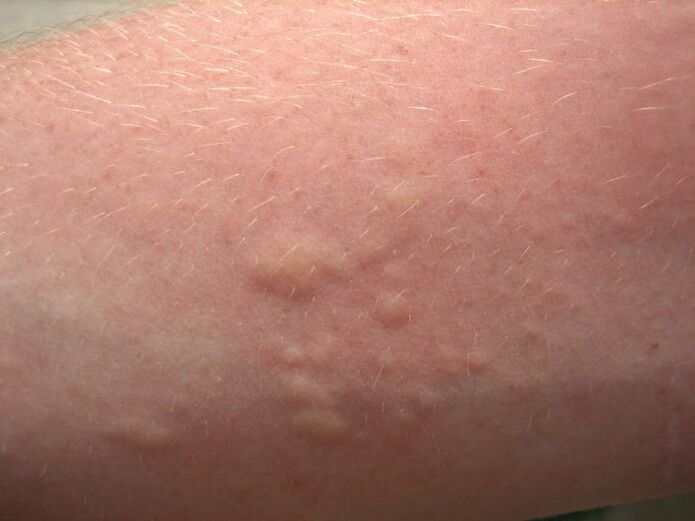
The disease is caused by roundworms. These parasites can only live in the human gut. The complex of symptoms depends on the intensity of the invasion and the age of the patient. The general symptoms of the disease are:
- itching allergic rash (such as vesicular or urticarial rash);
- fire situation;
- general anxiety;
- excessive sweating;
- weakness;
- enlarged liver;
- during migration: shortness of breath, cough, wheezing;
- anorexia;
- diarrhea and constipation;
- nausea;
- by the central nervous system: irritability, sleep and memory impairment, convulsions, meningitis; Liver abscess, obstructive jaundice, appendicitis, pancreatitis, and obstruction may develop with mass invasion.
Teniarinhoz
This disease is caused by tapeworm in cattle. At the initial stage, the disease is asymptomatic and can last for years. Sooner or later, these symptoms appear:
- weight in the epigastrium;
- nausea, heartburn;
- increased saliva;
- oral cavity;
- appendicitis, intestinal obstruction, obstruction of the bile ducts;
- weight loss against the background of increased appetite;
- vitamin deficiency;
- allergic reactions;
- dizziness, weakness, sleep disturbances, increased nervousness and irritability;
- arterial hypertension and tachycardia.
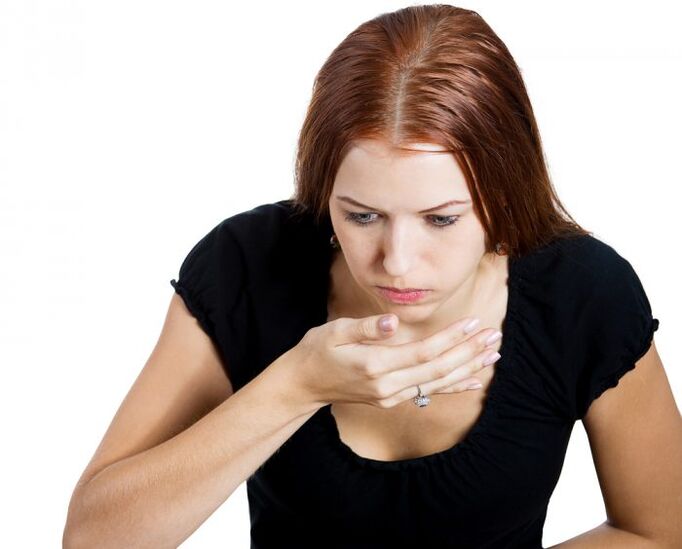
Enterobiasis
Pinworms cause this disease. This is the most common parasitic disease. The symptoms are as follows:
- itching in the anus, worse at night;
- scratching and redness in this area;
- sleep suffers, bruxism, drowsiness, lethargy appear;
- anorexia;
- abdominal pain, urinary incontinence in children;
- unstable stools, nausea, flatulence, vomiting;
- allergic reactions.
Toxocariasis

Toxocara worms can parasitize various human tissues and organs. However, regardless of the location, they constantly cause allergic reactions in the body due to the following types:
- Mosquito-like skin rash. The rash can appear on different parts of the body.
- Bronchial asthma manifests itself as a persistent dry cough with a small amount of sputum.
- Quincke's edema. The skin on a person's face and neck swells, which can lead to suffocation and death.
With the exacerbation of toxocariasis, the patient's temperature rises, there are signs of intoxication with anorexia and headache, lymph nodes increase.
Nekatoroz (ankilorman)
This disease is caused by helminths called nekator and hookworm. Occupation manifests itself with the following set of symptoms:
- When larvae are brought from the skin, dermatitis, urticaria and various rashes occur. There is swelling, itching and burning at the site of penetration. The invasive period lasts up to 12 days.
- The transition phase is also accompanied by allergic manifestations. In this case, the respiratory tract is damaged and bronchitis, pneumonia, tracheitis and laryngitis occur. The patient has a fever, cough, shortness of breath and hoarseness.
- After a few months, the intestinal phase of the disease begins. At this stage, there are signs of iron deficiency anemia and duodenitis. The patient has increased nervousness, fatigue and sleep disturbances. Women have menstrual disorders.
Important! Hookworm infection in childhood can cause mental and physical retardation.
Giardiasis
Giardia is a parasitic protozoal disease. A quarter of the population has an asymptomatic carrier of this microorganism. The following symptoms appear in the acute phase:
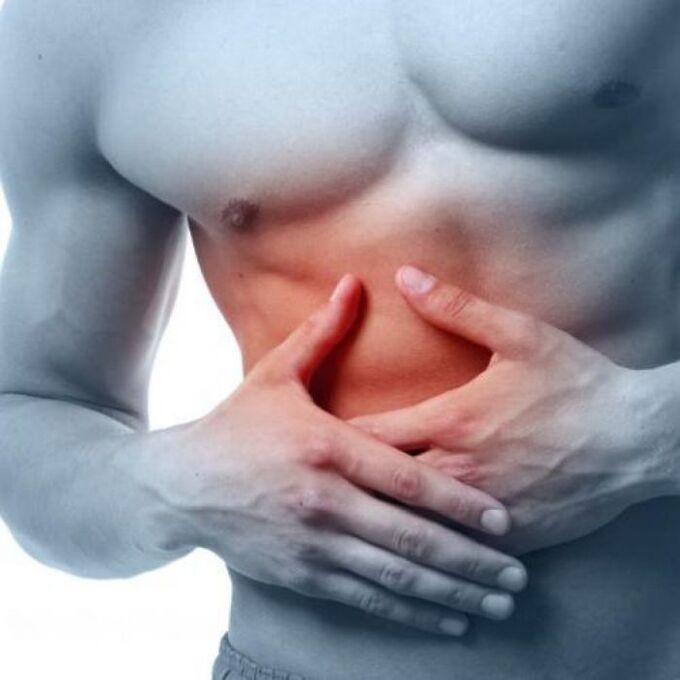
- disorders of the gastrointestinal tract;
- the patient suffers from pain in the right hypochondrium and around the umbilicus;
- flatulence, loss of appetite, belching, nausea are observed;
- diarrhea varies with constipation, often (up to 5 times) may be frothy stools;
- With a subacute course, intestinal symptoms persist, the patient loses weight;
- with mass invasion intoxication and fever;
- itching, urticaria and fainting in children;
- protozoa coprogram cysts are found in the feces.
Amoebiasis
The disease is caused by a histological amoeba. The disease can be asymptomatic or symptomatic. There are two forms of the disease: extraintestinal and intestinal. These protozoa can affect the brain, lungs, skin and genitourinary system. However, the most common is intestinal amemiasis. The symptoms are as follows:
- At the beginning of the disease, diarrhea is seen with a lot of frothy stools, followed by faeces like raspberry jelly. Their frequency is up to 20 times a day;
- severe pain is localized in the right abdomen;
- mild subfebrile condition;
- After 6 weeks, the acute process may decrease;
- examination may reveal protozoa in the stool.
Important! Amoebiasis never goes away on its own and is often recurrent. If left untreated, an amoeba is formed that causes intestinal obstruction.
difillobothriasis
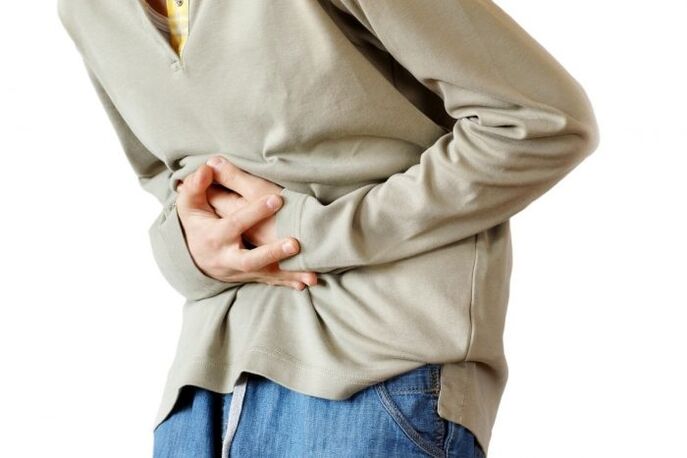
The culprit of this disease is a broad-leaved worm. A representative of these cestodes causes the following clinical picture of the disease:
- weight loss, fecal incontinence, loss of appetite;
- low temperature;
- fatigue;
- abdominal pain;
- anemia, weakness, dizziness, increased heart rate;
- worm fragments can be found in the stool;
- painful cracks appear in the mouth;
- depression and increased irritability.
Tenioz
The disease is caused by a tapeworm. The parasite is localized in the small intestine and causes the following symptoms:
- constipation, vomiting, diarrhea, nausea;
- vomiting and feces may contain parasitic segments (proglotids);
- anal itching, abdominal pain;
- suffers from sleep, dizziness appears.
Echinococcosis
Echinococcus can be asymptomatic for a long time. Then there is pain in the area of formation of an echinococcal cyst. In general, the symptoms are characteristic of a neoplasm of a particular organ. When the cyst ruptures, general intoxication, anaphylactic shock, and urticaria appear.
Types of parasites living in the human body
All kinds of parasites in the human body have a detrimental effect on his health. It infects the organs, feeds on nutrients necessary for human life, and releases harmful toxins. Therefore, it is very important to get rid of them in time.
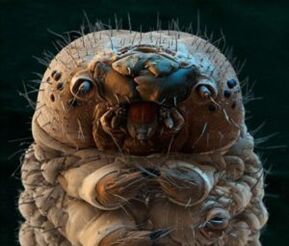
The human body is affected by various parasites, some living inside the body and some on the surface. They differ in size, ways of entering the body, and the characteristics of their vital functions.
What parasites live in the human body? How to get rid of them? What are the preventive measures? These issues will be discussed below.
Classification of parasites
Human parasites are very common, they are divided into groups:
- Endoparasitesare organisms that parasitize inside humans. This group, in turn, is divided into protozoa (consisting of one cell) and helminths (worms). The simplest parasitic amoeba in the human body, lamblia, Trichomonas, toxoplasma. As for worms, there is still a division into roundworms (nematodes), flat and tapeworms.
- Ectoparasitesare organisms that parasitize on the surface of the human body - lice, ticks, fleas, bedbugs. In addition to feeding on human blood and causing great discomfort (bites, burns, skin wounds), they carry very dangerous diseases: typhoid, anthrax, trypanosomiasis and others.
- Giardia.Giardiasis infection is a fecal-oral mechanism. Cysts (not yet formed, covered with a protective membrane) spread to vegetables, fruits and other foods after they are removed from the anus of a sick person. Through poorly washed hands, stagnant water, and insufficiently washed fruits and vegetables, cysts enter the human oral cavity, mature again, and multiply again from where they safely reach the intestines. The result is a bad period that will last until adequate treatment and hygiene measures are followed. Symptoms of the disease are weakness, fatigue, headache, diarrhea, abdominal pain and bloating. There may be itching in the anus, skin rash, bronchial asthma. It is characterized by pathological weight loss, anemia and weakened immune system. Treatment - Metronidazole, Furazolidone, Tinidazole. Dosage is determined by your doctor.
- Toxoplasma.Infection with this protozoa comes in contact with infected pets. In this case, a human is an intermediate host, because the sexual development of the parasite takes place in the animal's body. The disease manifests itself with a prolonged rise in temperature to subfebrile levels, signs of general intoxication, the patient develops enlarged lymph nodes, joint and muscle pain. There is also dysfunction of the gastrointestinal tract and visual organs, the central nervous system may suffer, there are signs of heart disease and endocrine system. Complex treatment is prescribed - tetracycline antibiotics and sulfanilamides.
- Trichomonas.Trichomonas is sexually transmitted, the risk of contact is minimal, but still present. Symptoms of the disease in women are itching, redness of the genitals, burning sensation and foamy discharge. Men may have difficulty urinating and have a discharge. Treatment - anti-trichomonas drugs.
Pinworm is an intestinal parasite
The most common internal parasites are pinworms. They live in the intestines and cause a disease called enterobiasis. This type of parasite affects not only humans but also apes. Risk group - children of preschool age, according to statistics, enterobiasis is diagnosed in half of children aged 2 to 10 years.
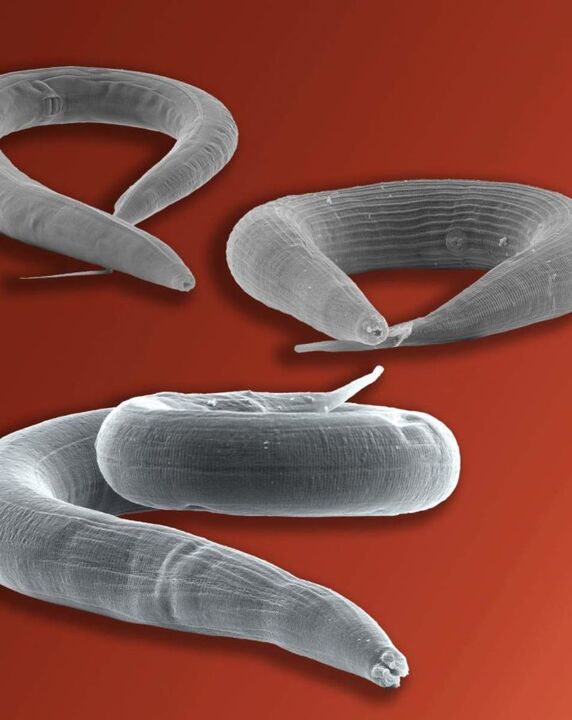
Worms are transmitted from person to person, you can be infected by any object used by a sick person or by shaking hands. The main condition for the transfer of pinworm eggs is not washing hands after contact, especially before eating. Worms, or rather their eggs, are carried by flies and cockroaches.
Pinworms can live only in the intestines, especially in the small intestine, colon and intestines. For mating, the parasites crawl out of the female anus and select the gut to lay eggs in the anus. Symptoms of pinworms in the body are itching in the anus, allergies, fatigue, anemia, abdominal pain, fatigue.
Levamisole, mebendazole, albendazole and other anthelmintic drugs are prescribed for the treatment of enterobiasis. Pinworm prevention is based on hand hygiene. They should be washed after visiting any public place.Roundworms - Roundworms
The length of an adult can reach 40 cm. Roundworms live in the human gut, lay their eggs naturally, and then continue to grow in the soil until they enter the human body. Dirty hands and unwashed vegetables and fruits are ways to infect roundworms. Roundworm eggs are covered with a shell that does not melt in the human stomach and allows roundworms to survive and enter the developing intestines of adults.
Ascariasis can be asymptomatic for a long time. Then there are symptoms that depend on the location and stage of development of the parasite. First, in the migratory stage of ascariasis, the patient is concerned about fever, cough with sputum, skin rash, migraine, enlarged lymph nodes, liver and spleen may appear. In the latter stage, when the parasite has already entered the intestines, fecal disorders are observed (symptoms such as dysentery, cholera, typhoid fever may be present). There are painful sensations in the abdomen, a sharp weight loss and fatigue.
Wide Ribbon
Infection with this parasite occurs through fish. This is the intermediate owner of the worm. You do not need to eat for the infection, sometimes it is enough to just come in contact with infected fish. Therefore, after cutting the fish, it is very important to handle your hands, knives and planks very carefully.
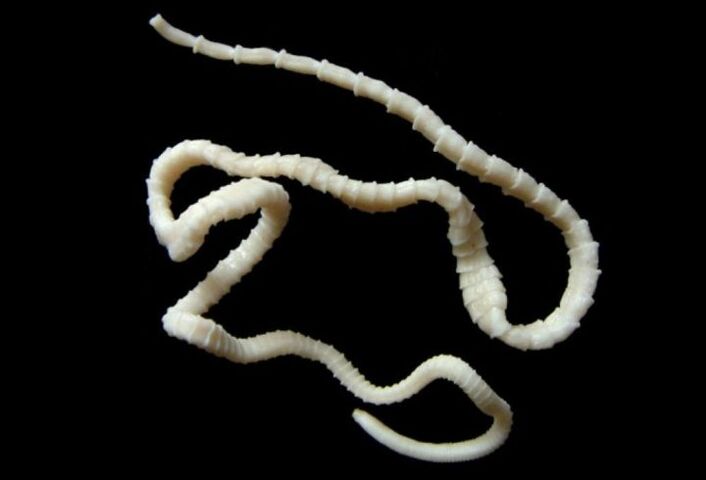
Neither worms nor their larvae are transmitted from a sick person to a healthy person. Symptoms of infection include nausea, vomiting, abdominal pain, increased or decreased appetite, and dyspepsia. The first signs of the disease may appear a month or two after infection. As a result of long-term presence of the parasite in the human body, pale skin, headache, increased heart rate, decreased blood pressure, weakness, anemia occur. The treatment is aimed at killing the worm. To do this, use Praziquantel, Niclosamide.
Bull lenteworm
The bovine worm can grow up to 12 m in length and is a hermaphrodite that can produce more than 100, 000 eggs excreted in the feces. The eggs fall to the ground, and then on the plants, these plants are eaten by cattle. In an animal's body, the egg turns into larvae localized in the muscles. If a person eats contaminated beef, the larvae enter the intestines. Larvae are not transmitted from person to person.
Adult worms have a body consisting of four suction cups, a neck and segments on the head. The number of segments is constantly increasing, the adult segments can separate from the worm and come out of the human intestine.
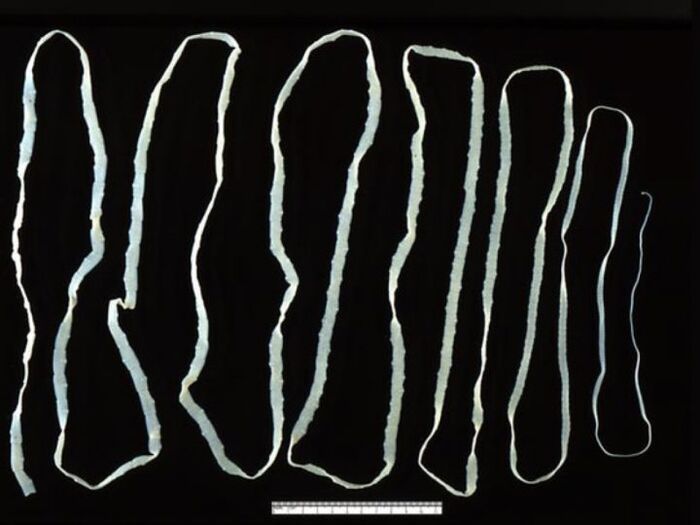
Symptoms of the disease are nausea, vomiting, dyspepsia, increased salivation, dizziness, weakness, nervousness, fatigue, abdominal pain of unknown localization, allergies, fluctuations in appetite.
There is a 3-step scheme for removing cow tape from the body: preparation (cleansing the body), treatment with antiparasitic drugs (Biltricid, Praziquantel, Niclosamide), recovery (diet, herbal medicine).
Pig ribbon worm
A person can be infected with pork worms through dirty hands, poorly cooked meat, dirty water, and an infected person can leave tapeworm segments and larvae around with vomit and feces. 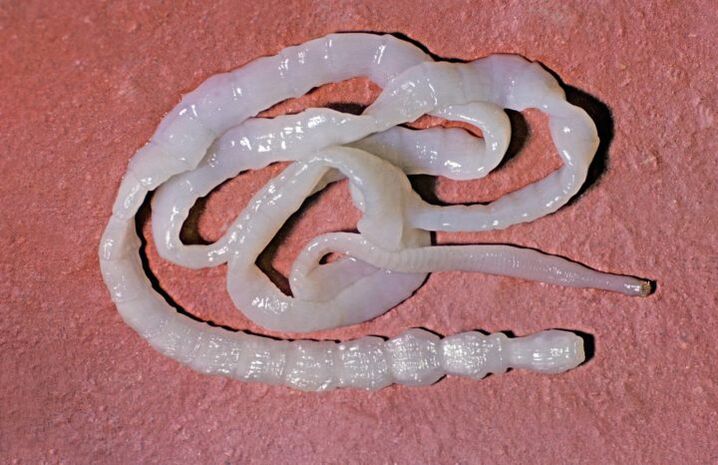 The worm can live in the human body for 15-17 years, attaches to the intestinal mucosa, and the larvae can spread throughout the body through the bloodstream and attach to any organ. It is especially dangerous for larvae to enter the brain.
The worm can live in the human body for 15-17 years, attaches to the intestinal mucosa, and the larvae can spread throughout the body through the bloodstream and attach to any organ. It is especially dangerous for larvae to enter the brain.
Pigs have an intermediate; People who come in frequent contact with raw meat are more at risk of contracting this parasite. Pigs can be infected by contact with both the chain and by eating meat that has been sufficiently heated. The meat must be cooked for a long time or frozen for 2-3 weeks in order to destroy all the larvae of the tapeworm.
Pig tapeworms feed on the small intestine, liver, brain, visual organs, muscles, etc. If the tapeworm affects vital organs, then a person may be paralyzed or even die.
Symptoms of swine fever: allergic reactions, abdominal pain, nausea and vomiting, weakness, dizziness, headache, weight loss, itching in the anus. The worm infects the intestinal mucosa, so the symptoms are very similar to enteritis.
Treatment consists of taking drugs that have a paralyzing effect on the worm, which in turn cannot and will not remain in the intestinal wall. But at the same time, it emits large amounts of toxins that can cause anaphylactic shock in humans. Therefore, treatment should be carried out only under the supervision of a physician.
Parasites in the mouth
Parasites in the human mouth can be represented by the following types:
- Trichomonas;
- oral amoeba;
- Diptera larvae (oral miyaz).
The clinical picture may be as follows:
- allergy;
- weakness, weight loss;
- bad breath;
- feeling of movement in the larynx;
- itching and sweating;
- nausea, loss of energy.
Worms in the mouth can destroy teeth and cause purulent deposits on the mucous membranes and tongue. Treatment is prescribed only by a doctor who takes into account the existing symptoms and types of parasites. A prerequisite for treatment is the examination of all people in contact with the patient.
Summary
Above, not all of them are considered to be the most common parasites that can live in the human body. It is important to understand the great danger of this neighborhood: worms in a person can cause very serious consequences and, consequently, the death of their owners. Therefore, it is very important to diagnose and get rid of parasites in time. As for preventive measures, they are mainly hygiene and quality roasting of meat.






































